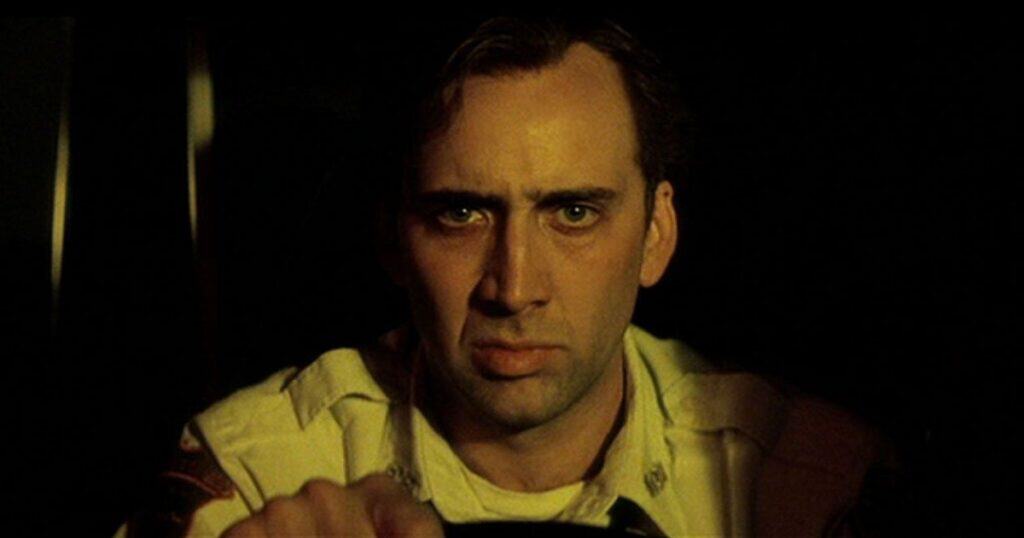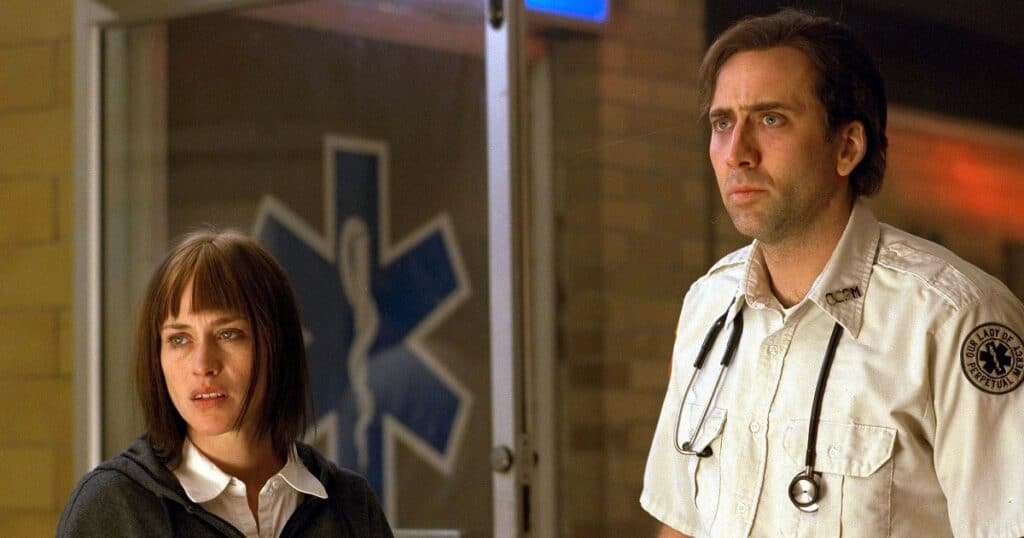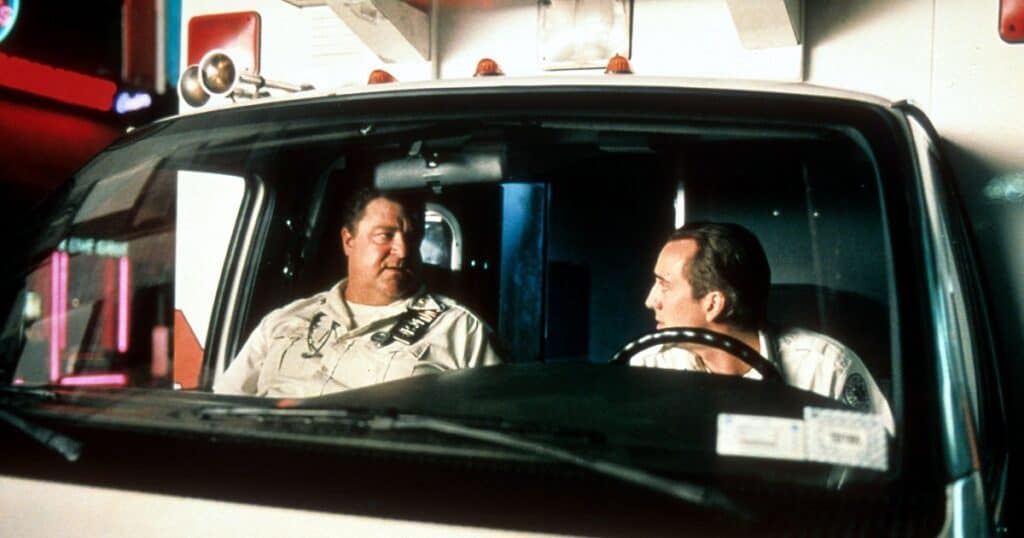
This year we, as horror fans, are going to be gifted with a film from director Oz Perkins. That movie is Longlegs and stars Maika Monroe as well as the fascinating actor Nicolas Cage. As anyone may know, Cage has starred in many different types of films, especially horror, and here, he stars as a serial killer who gives off some very Ghepetto-esque vibes. Regardless, we here at JoBlo will be there opening day for the film. As stated a minute ago, we recognize that Cage is vast in various types of genres…but this wasn’t his first dip in the pool of horror. Today on Horror Revisited, we are exploring Martin Scorsese’s underrated film Bringing Out the Dead (watch it HERE), which stars Nicolas Cage in one of his most honest, endearing and albeit best roles. So, turn on the sirens, strap in and let’s tour Manhattan as we check out Bringing Out the Dead.
For those of you that don’t know the plot of the film, let’s quickly go over it. In this movie we follow the intense life of Frank Pierce, a haunted paramedic in Manhattan. Set over three harrowing nights, the film delves into Frank’s psychological turmoil and sense of despair as he navigates the chaotic, often gruesome world of emergency medical services. Haunted by the ghosts of those he couldn’t save, particularly a young girl named Rose, Frank battles insomnia, guilt, and a deteriorating sense of reality. Amidst his nightly encounters with drug addicts, homeless individuals, and other distressed souls, Frank forms a fragile connection with Mary Burke, the daughter of a heart attack victim he’s trying to save.
The film explores themes of redemption, human suffering, and the thin line between life and death, all set against the gritty backdrop of New York City. While this may come as a surprise, it isn’t an original idea. Nope, this was adapted from the novel of the same name by author Joe Connelly. Connelly’s novel drew heavily from his own experiences as a paramedic in Hell’s Kitchen, New York City. The book offers a raw, unflinching look at the life of an EMT and the emotional toll of constantly dealing with life-and-death situations. Its vivid depiction of the urban landscape, coupled with the psychological depth of its protagonist, provided fertile ground for a cinematic adaptation.
In 1998, producer Scott Rudin acquired the rights to the novel through Paramount Pictures for a film adaptation. Paul Schrader was hired as screenwriter. His knack for exploring tormented, existential characters made him an ideal choice, and his screenplay retained the novel’s dark, introspective tone, delving deeply into the psyche of Frank Pierce, the haunted paramedic at the story’s center. Before we wrote the script, Paul went out on several ambulance runs to get a feel of what EMTs have to put up with on a normal night.

Martin Scorsese, intrigued by the novel’s gritty and unflinching look at life and death in the city, signed on to direct. Scorsese has also had a long-standing interest in gritty, urban narratives and his previous collaborations with Schrader, especially on Taxi Driver, made him a natural fit for Bringing Out the Dead. His direction aimed to capture the frenetic energy of New York City and the chaotic world of emergency medical services.
This movie has a huge cast. But let’s start with the standout, Nicolas Cage. He was cast as Frank Pierce, bringing his unique intensity and depth to the role. Cage’s portrayal of a man on the brink of psychological collapse is both compelling and heartbreaking and definitely at his A game. Originally, Paul Schrader had Edward Norton in mind for the role of Frank…imagine how that would have drastically changed the film. Patricia Arquette, who was married to Cage at the time, played Mary Burke, a woman who becomes a source of solace for Frank amidst his turmoil. The supporting cast includes John Goodman, Ving Rhames, Marc Anthony, Aida Turturro, Cliff Curtis and Tom Sizemore. Also, in a don’t blink or you’ll miss it role, is Judy Reyes. She plays an ICU nurse and would later go on to play a huge role as a nurse on Scrubs. Last but not least, Martin Scorsese and Queen Latifah provide voiceover roles for the two dispatchers. Gotta hand it to Marty to always cameo in his own films.
Production began in December of 1998. Filming took place in Manhattan and was shot over 65 days. Filming took place at night to accurately depict the paramedics’ graveyard shifts, which presented challenges in terms of logistics and maintaining continuity. The filmmakers also had to ensure the authenticity of the medical procedures and equipment used by the paramedics. Cinematographer Robert Richardson employed dynamic lighting and camera techniques to mirror Frank’s disoriented mental state, often using handheld cameras to create a sense of immediacy and chaos. When production wrapped, Marty would go on record stating he hated filming it because of the harsh December weather conditions.
As in any Socrsese film, we are treated to a standout soundtrack, usually some Rolling Stone songs. Here, as well, Marty selected a diverse range of songs that reflect the film’s themes and enhance its atmosphere. Some of these tracks include songs by Van Morrison, The Clash, R.E.M, UB40, Martha & The Vandellas and The Who. The songs complement Elmer Bernstein’s original score as well and make for a very engaging narrative.
Bringing Out the Dead would release in theaters on October 22,1999. On Its opening weekend it ranked 4th place, behind The Best Man, and grossed $6 million. Sadly, its domestic box office run was short, only grossing $16 million in total. Its budget was $55 million, so this was considered a huge flop.
Currently, the film sits with a 73% on Rotten Tomatoes with the critics consensus saying, “Stunning and compelling, Scorsese and Cage succeed at satisfying the audience.” Roger Ebert gave the film a four out of four rating saying, “To look at Bringing Out the Dead—to look, indeed, at almost any Scorsese film—is to be reminded that film can touch us urgently and deeply.” Stuart Klawans of The Nation wasn’t so kind to Cage’s performance saying “It’s another burnout role for Nicolas Cage, to which he brings his vast repertoire of grimaces and shuffles, as if he were variously impersonating a gargoyle on amphetamines and late Elvis on downers.”

Years later, Scorsese reflected on Ebert’s criticism and said “I had 10 years of ambulances. My parents, in and out of hospitals. Calls in the middle of the night. I was exercising all of that. Those city paramedics are heroes — and saints, they’re saints. I grew up next to the Bowery watching the people who worked there, the Salvation Army, Dorthy Day’s Catholic Worker Movement, all helping the lost souls. They’re the same sort of people.”
Bringing Out the Dead was released on VHS and DVD on March 28, 2000. Typically, when Paramount would release DVDs back in the day, you’d be lucky if it came with any special features at all, besides the film’s trailer. With this movie, it might not be much, but Paramount kindly provided Cast and Crew Interviews. Strangely, we’ve never seen a Blu-ray release for this movie. At the time of this edit being released, Criterion has it streaming on their channel. Here’s hoping that one of these upcoming months, that they will announce it with tons of behind the scenes bonus features. If we can get a 4K release of Raging Bull and a beautiful boxset of The Irishman, I don’t see why we can’t have this underrated gem too.
Through its depiction of Frank Pierce, a paramedic haunted by his failures, the film delves into complex themes that resonate deeply with audiences, so let’s highlight a few of them. At the film’s core, its about redemption. Frank is consumed by guilt over the lives he couldn’t save, particularly a young girl named Rose. This guilt manifests as haunting visions and insomnia, driving him to the brink of collapse. The theme of redemption is intricately woven into Frank’s nightly encounters, each call for help representing another opportunity to atone for past failures. The film portrays redemption as a challenging, often elusive goal, highlighting the internal struggle Frank endures as he seeks solace and forgiveness.
His journey is also one of isolation. His job isolates him from a “normal” life, and his inability to save lives isolates him from his colleagues and himself. The film’s depiction of New York City at night enhances this sense of isolation, with the city appearing both vast and lonely. However, moments of connection offer glimpses of hope. Frank’s interactions with Mary Burke, played by Patricia Arquette, provide brief reprieves from his loneliness. Their developing relationship serves as a counterpoint to Frank’s isolation, suggesting that human connection can be a source of healing even amidst despair.
And finally, the film’s setting in New York City at night serves as a backdrop for exploring urban despair and fleeting moments of hope. The city is depicted as a place of both relentless suffering and potential redemption. The harsh realities of urban life are portrayed through encounters with drug addicts, homeless individuals, and other marginalized people. Yet, amidst this despair, moments of compassion and human connection offer glimpses of hope. Scorsese’s depiction of the city captures its duality, reflecting the broader themes of suffering and redemption.

Bringing Out the Dead is a film that resonates with me on multiple levels, making it one of my all-time favorites. One of the primary reasons I love it is because of Martin Scorsese’s unparalleled direction. Scorsese brings his signature style to the film, capturing the frenetic energy and gritty reality of New York City’s nighttime streets. Scorsese’s ability to balance raw intensity with moments of quiet reflection is truly remarkable, creating a compelling and immersive experience that keeps me engaged from start to finish.
Nicolas Cage delivers an unforgettable performance bringing a raw emotional depth to the character that is both compelling and heartbreaking.His nuanced performance captures the vulnerability and desperation of a man on the brink of collapse, making Frank’s quest for redemption all the more poignant.
Despite its dark and intense subject matter, Bringing Out the Dead manages to find moments of connection and humanity amidst the chaos and despair. These moments of human connection serve as a counterbalance to the film’s darker aspects, highlighting the resilience and strength of the human spirit.
Over time, the film has gained recognition for its unflinching portrayal of the emotional and psychological toll on emergency responders. It is now appreciated as an underrated gem in Scorsese’s filmography, noted for its raw emotional power and stylistic boldness. The film’s re-evaluation by critics, enthusiastic word-of-mouth promotion, and increased accessibility through home media and streaming services have further cemented its status as a cult classic.
In conclusion, Bringing Out the Dead is a film that I appreciate for its masterful direction, compelling performances, and deep thematic exploration. It’s something beautiful that stayed with me after the credits started rolling, and will make me want to revisit it for a long time to come.
Two previous episodes of Revisited can be seen below. To see more of our shows, head over to the JoBlo Horror Originals channel – and subscribe while you’re at it!
The post Bringing Out the Dead (1999) – Scorsese/Cage’s Forgotten Horror Film appeared first on JoBlo.
Leave a Reply